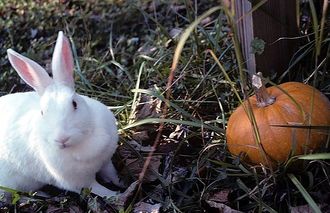Rabbits
Main > Food and Agriculture > Animal Husbandry
Rabbits are a very easy way to provide meat for a resilient community or ecovillage. If you want to breed animals for meat, what could be easier to breed than an animal notorious for its fertility? Two does and a buck can easily produce 2kg of meat a week in a 1m2 enclosure. The buck should be kept separate, and the doe placed in the bucks enclosure for mating. Rabbits can be fed most leaves and grass.
Droppings can be used to fertilize plants - no need to compost it first. The fur is useful too.
You can make delicious rabbit marinade by putting it in a pot with with red wine, chives, pepper and other spices, soaking it like that overnight in the fridge and then roasting it slowly.
Rabbits are best harvested at 8-12 weeks of age. See How to skin & prepare a rabbit
Want to see a creepy survivalist guy giving you good advice on how to raise rabbits? I thought so. Check out these YouTube videos:
- Part 1, mostly about cages
- Part 2, mostly about breeding and birthing
- Part 3, showing how fast they grow
- Part 4, slaughtering and skinning them
- Part 5, butchering
What breed to use
According to this guide (which is packed with useful information), 14 breeds are suitable for meat -
- Champagne d'Argent
- Californian Cinnamon
- American Chinchilla
- Creme d'Argent
- French Lop
- Hotot
- New Zealand
- Palomino
- Rex
- American Sable
- Satin
- Silver Fox
- Silver Marten
Of these 14 breeds, the New Zealand White rabbit holds the title for being the top breed to raise for meat purposes due to overall practicality for both the processor and the grower, and closely followed by the Californian. This determination is based on size, growth rates, feed conversion ratios, dress-out weights and meat-to-bone ratios.
The New Zealand White is fertile year-round and has a gestation period of about one month.
A Complete Handbook on Back-Yard and Commercial Rabbit Production a 92-page booklet issued by the Peace Corps.
